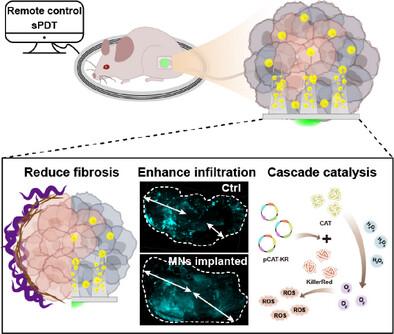植入光源-集成微针用于氯沙坦-肿瘤增强和持续光动力治疗
IF 19
1区 材料科学
Q1 CHEMISTRY, MULTIDISCIPLINARY
引用次数: 0
摘要
传统的光动力疗法(cPDT)通常是将间歇性的光照射到肿瘤部位,但它面临着一些限制,包括时间/位置限制、患者依从性差、光穿透深度不足、肿瘤微环境缺氧(TME)和纤维化屏障,这些因素共同影响了其治疗效果。为了解决这些挑战,研究人员提出了一种基于植入式微针的持续光动力治疗(sPDT)策略,该策略使用可提供氯沙坦持续释放的光源嵌入微针(MNs),实现四种协同功能:可穿戴无线发光二极管克服了cPDT的时空限制;给予含氟、可降解的多阳离子SS - HPT - F和pCAT - KR(一种能在同一细胞中表达过氧化氢酶和KillerRed (KR)的质粒)的复合物,以减轻长时间光照加剧的肿瘤缺氧;光集成MNs的原位植入解决了光穿透深度的不足;氯沙坦通过MN腔局部连续释放,绕过静脉给药的全身毒性,增强被纤维化屏障阻碍的肿瘤穿透。体内研究表明,该sPDT策略可显著增强肿瘤SS - HPT - F/pCAT - KR穿透,同时抑制肿瘤纤维化和TME中的缺氧状况,取得优于cPDT的治疗效果。该研究不仅解决了肿瘤内药物的渗透和积累问题,而且为推进光动力治疗提供了新的见解。本文章由计算机程序翻译,如有差异,请以英文原文为准。

Implantable Light Source‐Integrated Microneedles for Losartan‐Enhanced and Sustained Photodynamic Therapy of Tumors
Conventional photodynamic therapy (cPDT), which typically delivers intermittent light irradiation to the tumor site, faces several limitations, including time/location constraints, poor patient compliance, inadequate light penetration depth, hypoxic tumor microenvironments (TME), and fibrotic barriers, which collectively compromise its therapeutic efficacy. To address these challenges, an implantable microneedle‐based sustained photodynamic therapy (sPDT) strategy for treating tumors is proposed, using light source‐embedded microneedles (MNs) that can provide continuously release of losartan, enabling four synergistic functions: a wearable wireless light‐emitting diode overcomes the spatiotemporal constraints of cPDT; administrate a complex of a fluorinated, degradable polycationic SS‐HPT‐F, and pCAT‐KR, a plasmid which can express catalase and KillerRed (KR) in the same cell, to alleviate tumor hypoxia exacerbated by prolonged light irradiation; in situ implantation of light‐integrated MNs resolves light penetration depth inadequacies; and local continuously release of losartan through MN cavities bypasses systemic toxicity from intravenous administration and enhances tumor penetration hindered by fibrotic barriers. In vivo studies demonstrate that this sPDT strategy significantly enhances tumor SS‐HPT‐F/pCAT‐KR penetration while suppressing tumor fibrosis and hypoxic conditions in TME, achieving superior therapeutic efficacy over cPDT. This study not only addresses intratumoral drug penetration and accumulation but also provides new insights for advancing photodynamic therapy.
求助全文
通过发布文献求助,成功后即可免费获取论文全文。
去求助
来源期刊

Advanced Functional Materials
工程技术-材料科学:综合
CiteScore
29.50
自引率
4.20%
发文量
2086
审稿时长
2.1 months
期刊介绍:
Firmly established as a top-tier materials science journal, Advanced Functional Materials reports breakthrough research in all aspects of materials science, including nanotechnology, chemistry, physics, and biology every week.
Advanced Functional Materials is known for its rapid and fair peer review, quality content, and high impact, making it the first choice of the international materials science community.
 求助内容:
求助内容: 应助结果提醒方式:
应助结果提醒方式:


